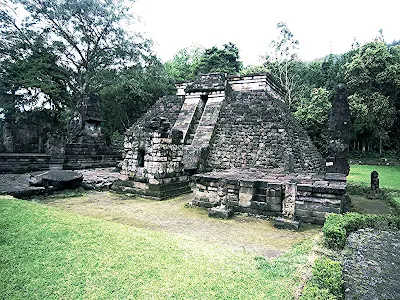Sukuh is a Hindu temple rows buildings
which is administratively located in the Village area Berjo, Ngargoyoso sub-district, Karanganyar, ex Surakarta, Central Java. This temple categorized as a Hindu temple since the discovery
object of worship phallus and yoni. This temple is considered controversial because of its less common and
because the depiction of human genitals in explicit in some figure.
Sukuh been proposed to UNESCO to be
one of the World Heritage Site since 1995.
A brief history of discovery Sukuh site was first reported at the time British government in Java in 1815 by Johnson, resident of Surakarta. Johnson was then assigned by Thomas Stanford Raffles to collect data- the data in order to write his book The History of Java. After
the reign of Great Britain passed, in 1842,
Van der Vlis, Dutch archaeologist, doing research. The first restoration began in 1928.
The temple is located in Sukuh, Berjo Village,Central Java. This temple is approximately 20 kilometers from the town of Karanganyar and 36 kilometers from Surakarta. The structure of the temple Plan Sukuh. Sukuh building gives the impression of simplicity striking at the visitors. Impression obtained from this temple so different from that obtained from major temples in Central Java the Borobudur and Prambanan. Shape Sukuh buildings tend to be similar to the Mexico Mayan cultural heritage or legacy Inca culture in Peru. This structure also reminded the
visitors will be forms of the pyramids in Egypt. This simplicity impression attract archaeologists illustrious Netherlands, W.F. Stutterheim, in 1930. She try to explain it by giving three argument. First, the possibility of sculptor Sukuh but not a bricklayer carpenter villages and not from the palace. Second, the temple made
with somewhat hastily so that less tidy. Thirdly, the political situation at that time with the approaching collapse
Majapahit, it is not possible to make temples large and magnificent.
The visitors who entered the main door
entering the biggest gate will see architectural forms Typical that is not arranged perpendicular but somewhat
oblique, trapezoidal in shape with a roof on it. Rocks in this temple reddish color, because stones used is the type of andesite .. The first terrace of the temple
The main gate of the temple Sukuh.
On the first terrace there is the main gate. At the gate There are a sengkala Memet in the Java language
Aban blind archway reads wong ("giant archway human prey "), which each have
meaning 9, 5, 3, and 1. If reversed then obtained years 1359 (Saka) (1437 AD). This year's figures often
regarded as the foundation of this temple, though more likely is the year of the completion of the gate built
this. On the other side there is also a relief sengkala Memet Intangible elephant turbaned snake tail biting. This
considered to symbolize the sound of blind anahut tail gate ("Giant arch bite tail"), which can also be interpreted as a Saka 1359. Relief sengkala at gate
Sengkala Memet (picture) which is interpreted as Aban wong blind arches.
Sengkala Memet were interpreted as blind gate anahut tail. The second terrace of the temple Gate on the second terrace is damaged. The right and left archway there is a statue that guards the door or Dwarapala regular there, but in a state of disrepair and has not clear shape again. Gate is not roofed and on this terrace there are a lot of statues. On this gate there is a language candrasangkala
Java which reads elephant tail means wiku anahut "Elephant Priest biting tail " in Indonesian. These words have meaning 8, 7, 3, and 1. If reversed
Saka then obtained in 1378 or in 1456 AD.
The third terrace of the temple
On the third terrace there are great courtyard with a temple parent and some of the panels on the left and be relief
statues on the right. Right above the main temple in the middle there is a
squares that looked like a place
put offerings.



Tidak ada komentar:
Posting Komentar